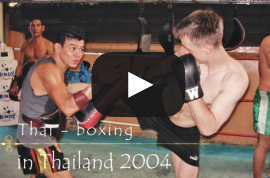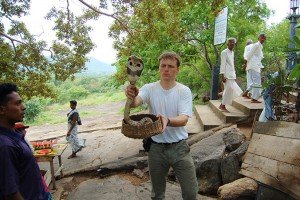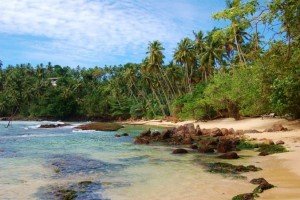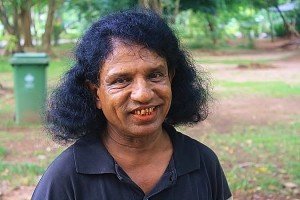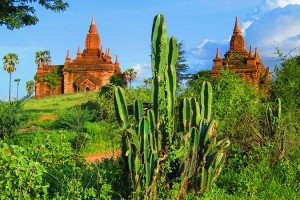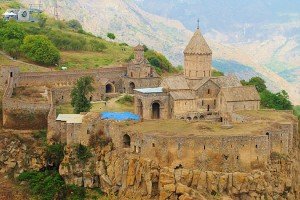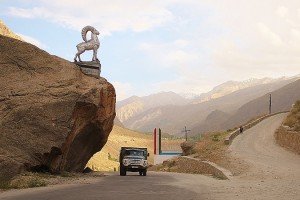Things to see in Manila
Things to see in Manila
Manila is usually the first contact with the Philippines. Although the country is mainly associated with natural beauty, I think Manila deserves a few days of sightseeing. The capital of the Philippines has historical monuments, interesting museums and gardens, as well as happy people.
Manila
I started my trip around the Philippines from Manila, of course. I was happy that I finally found time to travel in that beautiful country. However, before I went to admire the beaches and waterfalls, I spent a few days in Manila, where the Filipino adventure usually begins. I stayed in the suburb called Makati, because it was a very convenient place to tourists. There are a lot of cheap hostels in Makati at 400 pesos a night, plenty of bars, and it is relatively close to the tourist attractions in the centre.

Iconic jeepney is a symbol of the Philippines.
Apart from the tourist district, however, Manila is very tiring. The noise and exhaust fumes of that big city makes you want to leave, and head to the beautiful parts of the Philippines as soon as possible.
(I return to the subject of Makati at the very end of this article, and in a very interesting way).
Places of interests in Manila
In every Asian city there is always something interesting to see, and Manila has such places too. The first tourist attraction is definitely riding a jeepney, an iconic vehicle, decorated in kitschy patterns, according to the imagination of the driver. A jeepney ride is also a good experience because of the experiences with people. Each time I was on a board of a jeepney, I met someone different, and I always had different experiences. Some people stared at the white tourist during the whole ride, and with others I made a conversation. When sitting in a bar somewhere in a non-tourist district I quickly became a bar attraction, because “polar bears” in the Philippines occur less frequently, then for example in Thailand or Cambodia. Fortunately Filipinos have a happy and interesting nature, that’s why it is easy to make contact with them.
As for the information about the public transport in Manila, I went by jeepney from Makati to Gil Puyat, and from there I boarded an LRT train, and got off at the United Nations Avenue station. I think that this is the best and the cheapest way to get to the centre, from where tourists can either walk, or eventually take a horse cart, in order to get to all the places of interest.

Mother with son; Manila.
The Rizal Park
Rizal Park is a historical park in Manila, which covers an area of 60 hectares, and which is one of the biggest tourist attractions of Manila. On its grounds there is a large pond with a fountain, carefully manicured gardens, the Ethnographic Museum of the Philippines, interesting plant exhibitions, and monuments to the greatest heroes of the Philippines. Rizal Park is a popular meeting place where people come for walks, picnics and to do sports, but also to have contact with the Filipino culture and history, among many street sellers.
Rizala Square was named that way to commemorate the national hero of the Philippines Dr. Jose Rizal, on which the colonial authorities of Spain carried out an execution of the 30th of December 1896, for inciting the revolution. For that reason, in Rizal Square there is a statue of this hero and a high obelisk, surrounded by guards and Filipino flags. Another important date is the 4th of July 1946, when Philippines proclaimed its independence from the United States, also in Rizala Park. Rizala Park is often used for political and religious purposes too. On the 18th of January 2015, during the visit of Pope Francis to the Philippines, 6-7 million people gathered for a mass according to the official sources.

Rizal’s statue in Rizal Park, Manila; Philippines.
There are also very pleasant and relaxing places in Rizal Square, such as: Chinese Garden, Japanese Garden and Orchidarium. In my opinion, all those gardens are picturesque places opened to the public for a small fee, where there are ponds and exotic vegetation, as well as oriental statues, lanterns and pagodas. Orchidarium is a sanctuary of peace, where orchids grow over ponds and bridges. I recommend these three places to people who love plants and peace, because there you can take a break from the hustle and bustle of Manila. I advise to visit Rizal Park during the week, because on weekends it is crowded and taking pictures is very difficult.
Within the Rizal Park there is also the National Museum of Anthropology, with its numerous paintings and sculptures, as well as exhibitions showing the first ethnic groups living in the Philippines.
At the end of Rizala Square, on the Manila Bay, there is also the highly recommendable Manila Ocean Park, which is beautiful, interesting and worth a visit. There are a lot of sea creatures inside, and a great attraction is the ocean tunnel and a walk on the ocean floor. You can find out more at https://www.manilaoceanpark.com/.

Seller of mangosteen in the street of Manila.
By the way, I don’t know how it is possible to let the bay in the capital of the country to become a rubbish tip? Fortunately, the Philippine government has already addressed this problem.
Intramuros
Another important place in Manila are the objects inside the walls of Intramuros, which is the “Spanish city behind the wall” inside Manila. In Intramuros there are many post-colonial facilities, such as Fort Santiago, the Casa Manila Museum, the St. Augustine Church, and the Manila Cathedral. Me and my women traveled on foot, but if someone has a high class, he can ride a horse-cart on the cobbled streets of Intramuros.
Fort Santiago
Fort Santiago is a Spanish citadel, which today is one of the most important historic buildings of Manila. This fort was built by the Spanish conquistador Miguel Lopez de Legazpi in the years 1590-1593, although it was renovated in 1733. Fort Santiago served as colonial Spain’s military base, though also as a prison for the enemies of Spain. One of them was Jose Rizal, who was imprisoned there just before the execution, in 1896. In 1762, Fort Santiago was also the British base after Britain conquered Manila, and in 1898 the American flag was hung over Fort Santiago, starting the American colonialism of the Philippines.
Today, Fort Santiago is a very popular tourist attraction, and its characteristic parts are a massive gate decorated with bas-reliefs, and a moat surrounding the citadel. The Rizal’s Shrine deserves attention, where tourists can see his private belongings, and get to know the description of his path from the prison to the place of execution.

Santiago Fort, Intramuros, Manila.
Important churches
The Manila Cathedral is a large Catholic church that has been reconstructed and renovated many times. In 1571 it was only a small church, but it was expanded as a cathedral in 1579. The earthquake destroyed the cathedral in 1600, that’s why it was built again in 1614. Unfortunately it was destroyed again by another earthquake in 1645. The Manila Cathedral was destroyed and build again, and not only because of natural disasters, but also after the Allied bombing in 1945. Still, it is standing at the Plaza de Roma in Intramuros, and has a magnificent façade and a tower. Inside the cathedral there are monuments, paintings, a big altar, and huge organs.
The Manila Cathedral is a pleasant, secluded place of religious worship, in front of which there are horse-carts and street sellers.
Another important church is the Church of St. Augustine, built in 1607, making it the oldest church in the Philippines. This church is 450 years of history with a wonderful interior, where you can feel the weight of time. It is a work of art, where even non-Christians should go to admire its splendour. From the outside however, it should be refurbished by skillful Polish builders.

Manila Cathedral.
Other places worth attention
Casa Manila is certainly worth a visit. It is a museum with an attractive courtyard and a fountain, where one can learn about colonial life in the Spanish times of the 19th century. This museum was built in a traditional Spanish style in 1980s, and is a copy of San Nicolas House from 1850. Although it is not authentic, furniture and the colonial style are. I do recommend.
Another important place is Bahay Tsinoy, a museum documenting the history, life and contribution of ethnic Chinese to the life and history of the Philippines. The museum is named that way because the Chinese who settled in the Philippines called themselves “Chinese Filipinos”, so Tsinoys or Chinoys.
There are many places in Manila that tourists can see. There is for example the Science Museum in the Taguig district, which I recommend especially to families with children. There are exhibitions depicting a dinosaur, a whale shark, and there is also a small planetarium too. More at https://www.themindmuseum.org/.

Manila Bay.
Another interesting place is the American Cemetery, which is located on a well-maintained green area, where white crosses are arranged in even rows. There are American soldiers who died during World War II. The American Cemetery also serves as a museum, and even though it is certainly an interesting place, I approached it with a great distance, because in the case of the Philippines America was a colonial occupier. More at https://www.abmc.gov/.
We can also see the Malacanang Palace, which is the official residence of the Philippine president, but also Chinatown with its good food and Chinese tea. Ace Water Spa swimming pools are also very pleasant and relaxing, and it’s a place where we can easily forget about all problems – http://www.acewaterspa.com.ph/.
I spent whole day at the Manila zoo, in the Malate district, and it was very nice. I like animals, exotic vegetation and a quiet escape from a big city. In the zoo there were elephants, tigers, big birds and snakes, but this time I was mostly interested in the Palawan bearcat. It is a unique animal, sitting on a branch with rough hair and sharp claws. http://manila.gov.ph/tourism/manila-zoo/.
Last evening in Makati district – a “brothel under the open sky”
Makati is known as a business district, but in my opinion it is rather a district of whores, hookers, transvestites, and viagra vendors. When walking down the main street, white men are always booed and encouraged to have sex, even if they only want to go for a dinner in peace. I also just went for a walk and to buy something to drink, but in Makati men don’t have to look for a brothel because the brothel looks for men. Finally, I understood why this is a “business district” advertised as a tourist centre. I didn’t realize it when I first arrived.

School trip by the Philippine Anthropology Museum.
White tourists from Europe and America attract prostitutes that count on quick profit. There were not only female prostitutes on the tourist street; but also, worst of all, men dressed as women, with make-ups like ghostly dolls, trying to sell themselves to tourists. It was disgusting, repulsive! If that was not enough, there were always street vendors offering viagra. I thought: “so this is the way it is done in the Philippines.”
I personally recommend Makati as a hotel and transport base, although the night bars also offer many attractions that I do not recommend to families with children. By the way, I also recommend going to a dentist, what is cheaper than in the European countries. For the „adventurous one” and those willing to spend money, Manila does offer many unforgettable experiences, including in such districts as Malate, Ermita, and nearby Quezon City. Especially white men would not get lost there, because they are quickly found by the “female companions”. I personally recommend sights and cultural contact with Filipinos.
I would also like to point out that while prostitution in the Philippines is huge, young Filipino women are most often brought up in a very conservative Catholic way. I got this impression after travelling over 2.5 months in the Philippines. On the other hand Filipinos have sense of humor. When I was walking around the small towns in the Philippines, women often made fun of me. Young women from high school and college were shouting to me: “hey daddy, do you want a kiss?” And then the whole street laughed at me. They are very funny …

A scene from the street of Manila, with jeepney in the leading role.
When I was standing on the street, I had an interesting meeting. Well, the girls circled me to provoke some action. However, it got much more interesting when I was approached by an Arab, who lived permanently in the Netherlands, and who of course was with a Filipino prostitute. He asked me if I was going to bang something today, to which I replied that I would rather not. Then I asked him how long he had been in the Philippines. I asked if he saw whale sharks, waterfalls and beautiful beaches, but he quickly interrupted me and said that he didn’t care about any of that. He only came for whores for two months, and set a plan for two women a day, what means that within two months he wanted to have 60 women. At the end he smiled and said that Holland paid him benefits purely for that purpose.
The best thing however is, that the Dutch, German and Swedish women, who I met during my travels were fierce feminists who were open to the exotic immigration, but at the same time they approached the Pole with great reluctance, while showing their hearts to Muslims. In my opinion, white women are useful idiots that destroy white Christian civilization through their harmful leftist ideologies. If Muslims were the only problem in Europe, then in my opinion this would be half of the problem.
Summary of Manila
Manila can be visited in many ways, and although it is not the second Bangkok or Malacca, and despite its tiring traffic and noise there are several attractive places to see. Many tourists often bypass Manila, rushing to the beautiful beaches or rice terraces in the north. It’s hard to not to agree, that these destinations are much better, but I think that if someone has already landed in Manila, then they should at least spend 2 days there to see Rizal Park and its surroundings, and the colonial architecture inside the Intramuros walls. Everything except those two places is an addition. There are of course people like the Arab that I met on the street and who came only to the brothel, but I do not recommend such tourism.

A kite seller in Manila.
To me however, Manila is a good stop-over place, where one can see a few sights, and then plan an trip to the more attractive parts of the Philippines.




